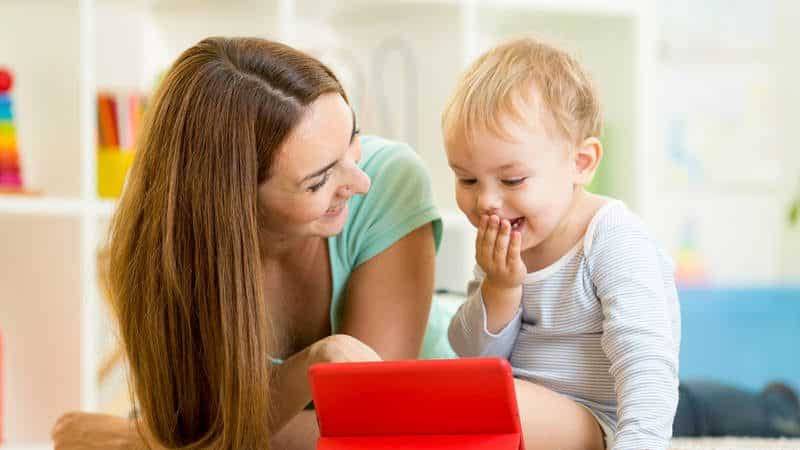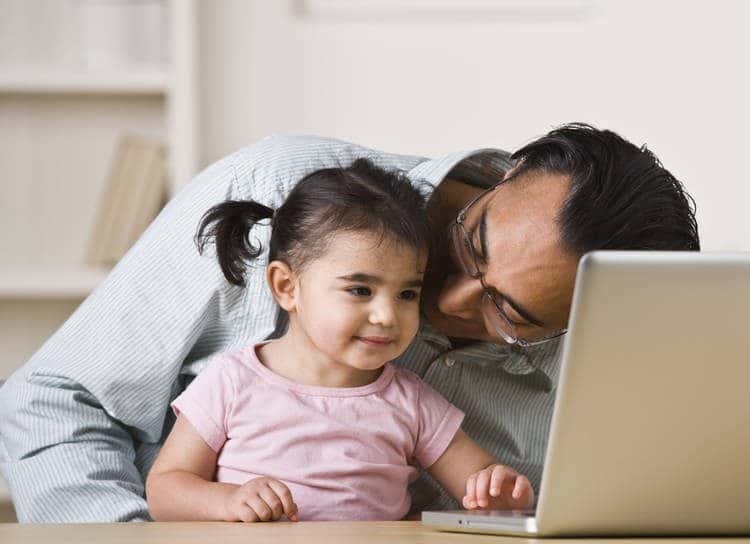Parents wonder whether screen time is educational, distracting, or both. It’s important to consider how and how much your little ones use screens.
Screens Are Everywhere
Everywhere you look, there’s a screen with bright pictures and interesting noises—phones and computers, tablets and TVs. You may wonder if all this technology is good for babies and toddlers. Is it educational, distracting, or some combination of the two?
It turns out that’s a great question to ask.
Recommended Screen Time
The American Academy of Pediatrics has recommendations for children’s use of “screen media.” Here’s what the Academy says is best for each age:
- Birth through 18 months
Avoid all screen media—phones, tablets, TVs and computers. (It’s OK to video chat with grandparents and far-away friends.) - 18 months to 2 years
It is OK to introduce young children to high-quality children’s media if you watch it with them and help them understand what they’re seeing. - 2 to 5 years
Limit screen use to one hour a day of high-quality programs designed for children. Watch with your children; explain what they’re seeing and how it applies to the world around them.
Tips on Using Media to Support Early learning
Your child learns most from her experiences in the real world. She learns by exploring, using her whole body and all her senses. A bird hopping along the sidewalk, a crackly leaf or a juicy red apple are easier for her to understand and remember than the objects she sees on a screen. Help your child connect what she sees on-screen with what she sees in the real world. Point out and name objects in real life that she’s seen on the TV, phone or tablet.
Your child learns most from his interactions with you. The conversations you have with your child are far more educational than mobile apps—even those designed for learning. Your child points to something that interests him, and you talk about it. “Yes, that’s a duck. What does the duck say?” You describe the new thing in relation to something that interested him the day before or the day before that. “Remember when you went to the park with Grandma? Did you feed the ducks?” Learning is connected to the feeling of being loved and supported as you discover the world together. Watch TV or use media with your child. Ask questions and talk about what you’re watching.
Your young child gets distracted by television, even when it’s on in the background. TVs offer loud voices, flashing lights and noise! Young children already have to sort out and make sense of so much information. Focusing is easier without the TV. Try to limit TV in the background when young children are playing and make sure to turn off the TV when no one is watching.
Your use of media shows your child what’s important and valuable. Everybody’s got friends who are attached to their phones—texting, updating social media and watching videos. It’s easy to feel left out or unimportant when the person across from you is looking down at a screen. This is not the message we intend to give our children, but it happens. The take-away? Shut off or silence your phone when you can. Use that time to connect with your child and experience the world together.

Here’s How You Can Find High Quality, Educational Screen Experiences for Your Child
Did you know that any program, app, or game can call itself educational? Many don’t actually help children learn or build the skills they claim. So, how can you find high-quality, educational screen experiences for your child? Here are six tips to guide your choices:
1) Choose media that’s guided by child development specialists and teachers.
Organizations like PBS rely on experts in early development to help them develop children’s media programming. This approach ensures that their media focuses on the skills and concepts that young children are ready to learn.
E—Content is Engaging to the child—interesting, challenging, and includes a learning goal.
A I—Content Actively Involves the child—sparking their thinking and participation.
M—Content is Meaningful and reflects child’s everyday world and routines.
S—Content is Social, encouraging the child to respond within the game or program, as well as to interact with parents and others.
2) Choose “just right” media experiences.
Choosing age-appropriate media—programs, apps, and games that are designed for your child’s age and stage—is important. Screen media content should reflect children’s everyday lives and daily routines, which makes it easier for them to understand and make sense of what they’re watching. When children use media for older kids, they don’t learn as much and can get confused or frightened by what they see. Your child should be interested, challenged, and engaged when they’re watching or playing on-screen, but not bored, confused, or frustrated.
3) Choose screen experiences without lots of distractions.
This means no “extra” sounds or pop-ups on the screen take your child’s attention away from the story or activity. Often children can be distracted by tapping or swiping to make things happen on screen.
4) Choose screen experiences that use rich language and give children a chance to participate and respond.
Look for media where characters speak directly to your child, ask your child questions, and label or explain new words or concepts.
5) Share in the experience with your child.
Ask them what they are interested in, so they can be part of choosing screen content. Talk with them as you watch or play, including during videochat, programs, apps, and e-books. Ask questions about what you are seeing. Connect the screen activity back to their daily world—if you watch a show about making a cake, do some baking together over the weekend.
6) Choose screen experiences that protect your child.
Many games and apps—even those designed for toddlers—don’t protect your child’s privacy and may expose them to inappropriate ads or content. Before you choose a screen experience, check out unbiased reviews (like those from commonsensemedia.org). Read the privacy policy for the game or app. Make sure that your child is not being pushed to purchase items within or outside the app/game. Co-watch/co-play with your child to make sure that pop-up ads don’t contain confusing or inappropriate information.
Making decisions about children’s screen time is a parent’s job, and we know it’s not easy. Limiting the time the children spend on screens (see here for guidelines), and choosing high quality programming when children do watch is a helpful approach for many families.
For more guidance on children and screens, visit our Screen Sense series.
Television Plays a Limited Role in Learning
Although children may learn some concepts from watching educational programming, they learn best from interactive, hands-on experiences—touching, feeling, shaking, stacking, problem solving—with people they care about. Research has found that some children’s shows (such as Arthur, Clifford, Dragon Tales, Dora the Explorer, and Blue’s Clues) have positive effects on children’s learning, but other shows (like Teletubbies or Barney & Friends) do not. In general, it’s best to choose age-appropriate programs in which:
- television characters occasionally speak directly to children and
- television characters ask children to participate in the show in some way (e.g., repeating a word).
Children’s shows with a strong storyline and storybook structure (beginning, middle, end) are also good.
What You Can Do:
Talk about the program. Ask 2- and 3-year-olds what they thought the show was about, which characters they liked and disliked, how it made them feel.
Answer children’s questions. Children are still figuring out new ideas and concepts. Sometimes they need your help to make sense of what they’re seeing on the screen.
Point out and name things they see on the screen.
Be active while you watch. Dance to the music, hop around like the bunnies on the show, and so forth.
Connect what children see on TV to children’s “real lives.” “Do you remember we watched a show about a mail carrier this morning? Here comes our mail carrier! Do you want to watch her deliver our mail?”
When the show is over, turn off the TV and act out the story. Use puppets to tell the story, or make up your own story to act out together.
Finally, do not use television shows or videos to put children to sleep. This makes it more difficult for them to learn to fall asleep on their own. Also, young children need the love, safety, and security that comes from naptime routines (story, back rub, song) shared with you.




